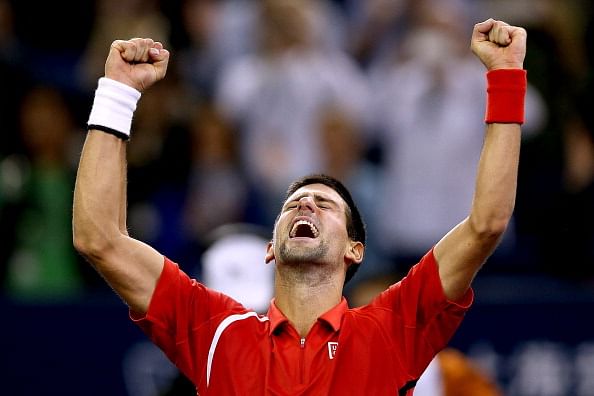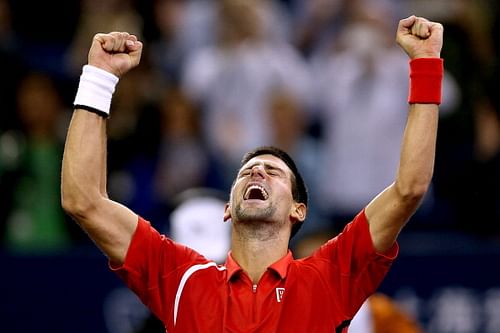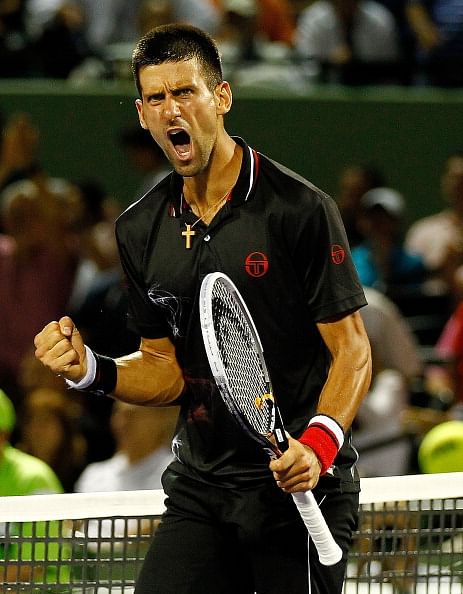
The Djoke's always been on you

During the course of explaining his grounding in tennis, Andre Agassi says in his autobiography Open that his father, Mike, wanted to turn him into tennis’s “ultimate counter-puncher: a returner.” During the entirety of his professional career, Agassi found himself up against giant servers like Pete Sampras and Goran Ivanisevic, and still became one of only five (at that time) players to win all four Grand Slams in the sport.
A decade or so on, another exceptional ‘returner’ nearly matched that feat in a single year, winning three of the four Slams and dominating the game on clay, the only surface in which he failed to win a Major. Indeed, if Novak Djokovic‘s success on grass at Wimbledon in 2011 was a surprise, his loss to Roger Federer (of all people) on clay in the semifinals of the French Open at Roland Garros, was an even greater shock.
The Serb had dominated the Masters 1000 events during the claycourt swing of the season, coming off the back of titles at the Australian Open, Indian Wells and Miami Masters before beating ‘King of Clay’ Rafael Nadal in both the Madrid and Rome finals. If anyone could have stopped his unbeaten run on all surfaces dating back to the Davis Cup 2010 Serbian success, it seemed it would be world No.1 Nadal who would do so. Especially on clay.
But just as he has made a habit of doing these last two years, Federer stepped in and spoiled the party, stopping what would have been a third Nadal-Djokovic final inside a month. That much anticipated final on the Philippe Chatrier court did happen a year later, but this time when Djokovic had slipped much below his 2011 standards, despite repeating his success Down Under and in Miami.
 But after a self-confessed disappointing run following the finals loss at Roland Garros, Djokovic seems to have rediscovered his mojo over the last month, garnering back-to-back titles in Beijing and Shanghai. Even more heartening for his fans was the manner of the victories, which expect for the final in Shanghai against Murray, featured very few heart-stopping moments and even then, saw him claw his way out like the Djokovic of 2011.
But after a self-confessed disappointing run following the finals loss at Roland Garros, Djokovic seems to have rediscovered his mojo over the last month, garnering back-to-back titles in Beijing and Shanghai. Even more heartening for his fans was the manner of the victories, which expect for the final in Shanghai against Murray, featured very few heart-stopping moments and even then, saw him claw his way out like the Djokovic of 2011.
Now, the 25-year-old is set to regain the world No.1 title from Federer, unless the Swiss star can somehow recapture his form from a year back on indoor courts. With the 12-month points logging system followed by the Association of Tennis Professionals (ATP), Djokovic has far lesser points to defend from now till the end of the season as compared to Federer.
Victories at the 2011 ATP World Tour Finals (1500 points), the Masters 1000 Paris and the World Tour 500 in Basel leaves the Swiss master with a total of 3000 points to defend. Djokovic on the other hand, has just a round robin appearance at the Finals (200 pts), a quarterfinal showing in Paris (180 pts) and a semifinal in Basel (180 pts) to defend or better. With the Djoker’s win in Shaghai on Sunday, all that separates the world No.’s 1 and 2 is just a total of 195 points.
And if you look at the overall efficiency of Djokovic and Federer’s game, especially on return of serve, it only makes sense. Djokovic is second overall in percentage of return games won in the calendar year, winning 35% of all service games faced. The only player ahead of him in that parameter is Nadal at 38%. However, the injury-ridden Spaniard has only taken part in 48 matches throughout the year as compared to Djokovic’s 81.
Even this level of 38% is much lesser than the heights he had hit during his record-breaking year in 2011. While staying unbeaten for 43-odd games in 2011, Djokovic at one time had been recording a phenomenal win percentage of 46% on his opponent’s service games!
In 2012, Juan Monaco and Andy Murray are third at 32%, having played 55 and 65 matches respectively while Federer finds himself down in 12th place, having won just 27% of his opponent’s serves in 73 matches. In fact, in a Grand Slam five-setter, facing on average 24-26 service games, Djokovic would win 8.4 to 9.1 games returning serve, while Federer would win only 6.5 to 7 return games.
Nadal leads the way in break points converted and in points won returning first serve, while Djokovic is second in both these lists. Federer is 16th in break points converted and 15th in points won on his opponent’s first serve. Djokovic is again 4 percentage points better off than Federer when it comes to facing his opponent’s second serve, helping him maintain pressure on his opponent to get his first serve in.
For a television producer looking to do a highlight reel of Djokovic’s career, maybe some 7-10 years from now, there will be plenty of wacky Gangnam-style dance pieces, press conferences wearing blond wigs, amazing tweeners like the one at 30-0, with Murray serving for the match in the second set on Sunday in Shanghai, and unbelievable forehand crosscourt winners off first serve in the fifth set of the 2011 US Open semifinal against Federer, when he was two points away from going out in front of a packed centre-court in Flushing Meadows.
And most probably, they would have clippings from a career when the Serb lifted all four Slams, ATP Finals, all Masters 1000 and the Davis Cup title. An Olympic gold in 2016? Maybe that too.